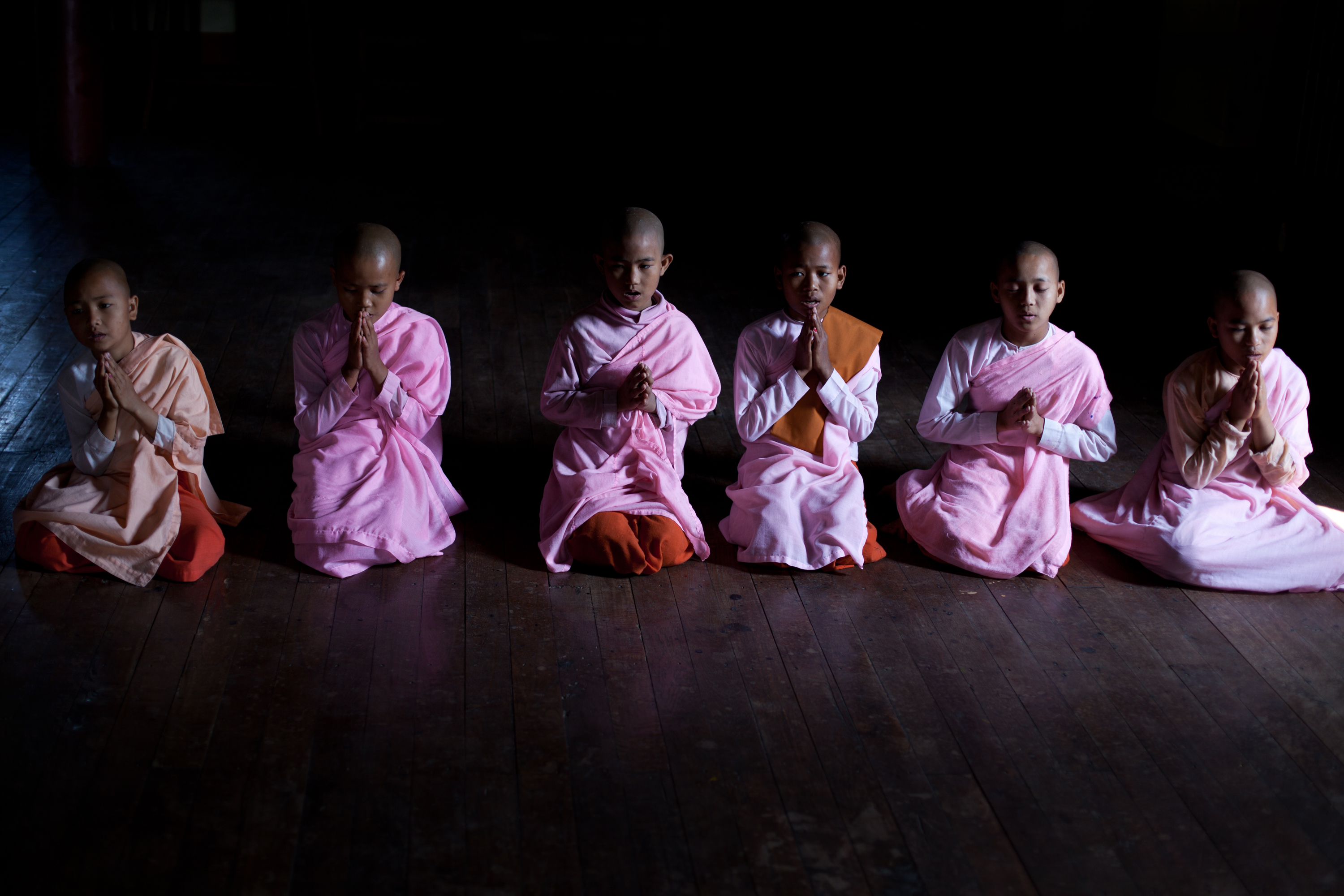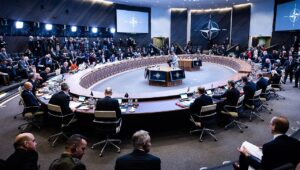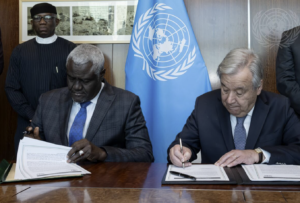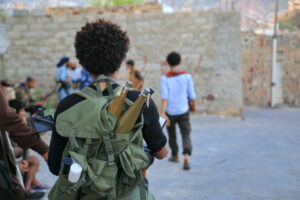Executive Summary
Freedom of religion or belief (FoRB) is a human right, recognized by the Charter of the United Nations, the Universal Declaration of Human Rights, the 1966 International Covenant on Civil and Political Rights, and the 1981 Declaration on the Elimination of All Forms of Intolerance and Discrimination Based on Religion and Belief. Today, that right is being tested by rising or sustained violence against persons on the basis of religion and belief—a threat that is largely underrecognized by the international community, even as new data show increases in many types of such violence. As a result, there has been a noticeable gap in response from the UN Security Council and international human rights mechanisms. What can and should be done, in the context of the United Nations and the UN Security Council? This issue brief examines the issue of FoRB through a security lens, considers the impact of the increase in this type of violence, and sketches opportunities for the UN and member states to take action to prevent and counter it.
This issue brief starts by outlining the major trends in violence based on religion or belief, identifying recent rises in violence perpetrated by both state and non-state actors. Next, it unpacks the links between restrictions on FoRB and violent conflict, and highlights conflict risks around religion or belief. The issue brief then summarizes important actions the UN has taken to prevent and counter violence based on religion or belief. Finally, it explores key risks and opportunities for strengthening UN efforts, offering recommendations for UN member states to advance this agenda.
Ultimately, the international community, including the UN, should understand the immense harm this type of violence can create—as an erosion of human rights, as a feature of mass atrocities, as a threat to governance, sovereignty, and the rule of law, and as a risk factor in violent conflict. UN bodies including the Human Rights Council, the General Assembly, and the Security Council have taken important steps to combat this type of violence, but UN member states should strengthen and build on those activities in order to reverse rising trends and protect civilians from violence based on religion or belief.
I. Trends in violence based on religion or belief
In most categories, violence based on religion or belief has increased significantly in recent years. Government force based on religion or belief is on the rise, while mob violence, property damage, and use or threat of violence to impose religious norms by non-state actors are growing concerns. And though the number of religion-related armed conflicts is declining, they continue to have tremendous impact on civilians.
This section summarizes these major trends to inform policy analysis on how the UN system should respond, examining violence perpetrated by both state and non-state actors. Except where otherwise stated, all figures shared in this section are taken from 2018 data published by the Pew Research Center.1Appendices D and F in Samirah Majumdar and Virginia Villa, In 2018, Government Restrictions on Religion Reach Highest Level Globally in More Than a Decade, Pew Research Center, November 10, 2020, https://www.pewforum.org/2020/11/10/in-2018-government-restrictions-on-religion-reach-highest-level-globally-in-more-than-a-decade/.
Rising violence by state actors
A steady global increase in government restriction of religion or belief has paralleled a rise in government violence based on religion or belief. The Pew Research Center reported government use of force2The Pew Research Center categorizes state activities under government force when they “resulted in individuals being killed, physically abused, imprisoned, detained or displaced from their homes, or having their personal or religious properties damaged or destroyed.” Pew Research Center, Appendix D, p. 79. against religious or belief communities in 95 countries in 2018.
State-perpetrated violence that resulted in death occurred in 20 of these countries, an increase of 25 percent since 2007. Violence carried out by state forces that did not result in death took place in 40 states. Of the different types of government force related to religion or belief, government-caused property damage showed the greatest spread, reported in 69 countries in 2018 compared to only seven in 2007.
The governments of China, Myanmar, and Turkey have used widespread force against religious or belief minorities, with each of the three responsible for over 10,000 recorded incidents of force based on religion or belief in 2018 alone. In the same year, the governments of Eritrea, Iran, Iraq, Rwanda, Syria, and Uzbekistan were each responsible for between approximately 1,000 and 10,000 incidents of force against religious or belief communities.
Government hostilities involving physical violence against minority or non-registered religious groups rose by 19 percentfrom 2017 to 2018 (and spread from 47 countries in 2017 to 58 countries in 2018). As of 2018, Baha’is, Scientologists, Sikhs, Rastafarians, and Zoroastrians faced harassment by state actors in 50 countries, compared to harassment by non-state actors in 25 countries.3Pew Research Center, In 2018, Government Restrictions on Religion Reach Highest Level Globally in More Than a Decade, p. 28.
State attempts toeliminate the presence of at least one religious group from the country (through violent or non-violent means) have been recorded in Afghanistan, Algeria, Azerbaijan, Bahrain, China, Comoros, Egypt, Eritrea, Indonesia, Iran, Iraq, Malaysia, Myanmar, Pakistan, Russia, Syria, Tajikistan, Turkmenistan, Vietnam, and Yemen.
Additionally, the alignment of many states with a specific religion negatively impacts the ability of the government to protect women, girls, and LGBTQ+ persons from violence. In a number of countries, insufficient legal and policy protections against domestic violence allow for marital rape and “honor killings” with few or no repercussions for the perpetrator.4Special Rapporteur on Freedom of Religion or Belief, A/HRC/37/49: Report on State-Religion Relationships and Their Impact on Freedom of Religion or Belief, March 2018, UN Office of the High Commissioner for Human Rights, https://www.ohchr.org/EN/Issues/FreedomReligion/Pages/ReportStateReligionRelationships.aspx, para. 41. For example, in Sri Lanka, the 1951 Muslim Marriage and Divorce Act details no minimum age for marriage nor mandates consent from the woman or girl, leaving Muslim women and girls disproportionately at risk.5“Sri Lanka” in 2019 Report on International Religious Freedom, U.S. Department of State, June 10, 2020, https://www.state.gov/reports/2019-report-on-international-religious-freedom/sri-lanka/.
Rising violence by non-state actors
In 2017, the Pew Research Center recorded the highest peak in social hostilities related to religion or belief6The Pew Research Center defines social hostilities involving religion as “acts of religion-related hostility by private individuals, organizations or groups in society.” Pew Research Center, In 2018, Government Restrictions on Religion Reach Highest Level Globally in More Than a Decade, p. 12. (a category that includes violent and non-violent behaviors).7Pew Research Center, In 2018, Government Restrictions on Religion Reach Highest Level Globally in More Than a Decade, p. 12. Following a slight decline in 2018, social violence resulted in one or more deaths in 39 countries, with non-fatal assaults occurring in 66 countries.
Of all types of non-state religious violence, property damage and the use or threat of violence to impose religious norms and practices have seen the largest increases, with these two categories more than doubling since 2007.
Mob violence is also a mounting concern, occurring in 41 countries in 2018 (with resulting deaths in Burundi, the Central African Republic, Ethiopia, India, Iraq, Lebanon, Libya, Malaysia, Nigeria, Papua New Guinea, Sri Lanka, Syria, Tanzania, Uganda, and Zambia). India is a prominent concern, with recent mob attacks resulting in mass deaths. In December 2019, government-fomented mob attacks against those protesting the discriminatory Citizenship (Amendment) Act led to nearly 25 deaths.8U.S. Commission on International Religious Freedom, Annual Report 2020, April 2020, https://www.uscirf.gov/sites/default/files/USCIRF%202020%20Annual%20Report_Final_42920.pdf, p. 20. In February 2020, mobs killed over 50 people in attacks against Muslim neighborhoods in Delhi, with police either standing by or participating in the violence.9U.S. Commission on International Religious Freedom, Annual Report 2020.
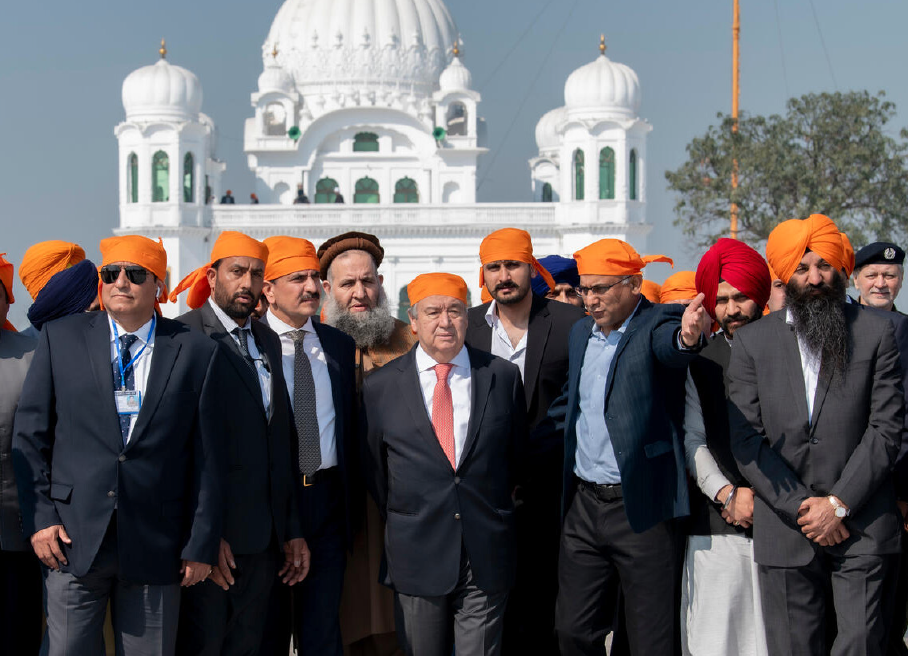
Credit: UN Photo/Mark Garten
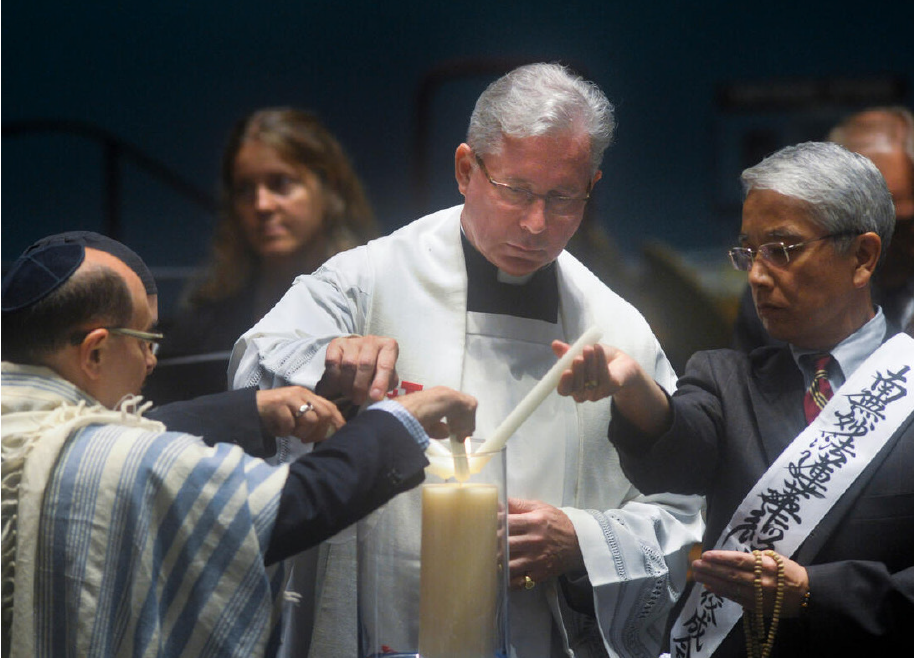
Credit: UN Photo/Evan Schneider
While acts of religion-related terrorism10The Pew Research Center defines religion-related terrorism as “politically motivated violence against noncombatants by subnational groups or clandestine agents with a religious justification or intent.” Pew Research Center, Appendix D, p. 87. have spread to only a small number of new countries, the number of casualties resulting from such acts has increased significantly. In one decade, the number of countries that experienced 50 or more injuries or deaths from religion-related terrorism increased by 24 countries, from eight countries in 2007 to 32 countries in 2017. Examples include attacks against civilians by ISIS in Iraq and Syria, the Taliban in Afghanistan, Al-Shabaab in Somalia, and Boko Haram in Nigeria.
Declining trends in violence
From 2007 to 2018, religion-related war or armed conflict11The Pew Research Center defines religion-related armed conflict as when in armed conflict “religious rhetoric is commonly employed to justify the use of force, or in which one or more of the combatants primarily identifies itself or the opposing side by religion.” Pew Research Center, Appendix D, p. 88. declined from 21 to 13 countries. However, these 13 conflicts continue to have grave impacts on civilians. In 2018, religion-related armed conflict took the greatest toll on the populations in:
- Syria (with millions killed or displaced),
- Afghanistan, Nigeria, Somalia, and Yemen (with hundreds of thousands killed or displaced), and
- India, Iraq, Libya, Philippines, and Sudan (with tens of thousands killed or displaced).
Interreligious violence12The Pew Research Center defines interreligious violence as “acts of sectarian or communal violence between religious groups.” Pew Research Center, A Closer Look at How Religious Restrictions Have Risen Around the World, July 15, 2019, p. 32. has also been steadily declining on a global level and in all regions, except for Sub-Saharan Africa.13Pew Research Center, A Closer Look at How Religious Restrictions Have Risen Around the World, p. 32. However, numerous incidents of interreligious violence can be found in the Central African Republic, Egypt, India, Iraq, Israel, Mali, Nigeria, Pakistan, Sri Lanka, Syria, Thailand, and Yemen.
II. Links between restrictions on religion or belief and violent conflict
Building on the previous section’s summary of trends, this section outlines the available scholarship on whether and how FoRB restrictions are linked to violent conflict, in order to examine FoRB through a security lens. The relationship between FoRB restrictions and violent conflict also has important implications for whether and how the UN Security Council, which deals with threats to international peace and security, should engage with the FoRB agenda—a question addressed in subsequent sections.
Violence based on religion or belief occurs in both conflict and non-conflict settings, though the highest levels of death occur in armed conflict contexts.14Minority Rights Group International, Peoples under Threat 2018, https://minorityrights.org/wp-content/uploads/2018/06/Peoples-under-Threat-briefing-2018.pdf, p. 9. Religion-related atrocities are always cause for alarm, and can take place within or outside armed conflict settings. Religion-related mass atrocities identified by the Special Rapporteur on FoRB to be of particular concern include violence targeting Muslim communities in the Central African Republic, predominantly Muslim Rohingya communities in Myanmar, and Yazidi communities in Iraq.15Special Rapporteur on Freedom of Religion or Belief, A/75/385: Report on Safeguarding Freedom of Religion or Belief for the Successful Implementation of the 2030 Agenda for Sustainable Development, United Nations Office of the High Commissioner for Human Rights, 16 October 2020, https://www.ohchr.org/EN/Issues/FreedomReligion/Pages/ReportFoRBandSDGs.aspx, para. 37 and 38. Research and human rights organizations also widely consider the forced internment of predominantly Muslim Uyghurs in China16Lauren Baillie and Rachel Vandenbrink, “China: The International Community Is Failing Xinjiang’s Uyghurs,” United States Institute of Peace, December 30, 2020, https://www.usip.org/publications/2020/12/china-international-community-failing-xinjiangs-uyghurs. and the targeting of Christians by Boko Haram in Nigeria17Ewelina U. Ochab, “After Years of Impunity for Mass Atrocities, Nigeria Faces a New Wave of Violence by a Daesh Affiliated Group,” Forbes, February 20, 2020, https://www.forbes.com/sites/ewelinaochab/2020/02/20/after-years-of-impunity-for-mass-atrocities-nigeria-faces-a-new-wave-of-violence-by-a-daesh-affiliated-group/?sh=565e367b77c7. to be atrocities.
Researchers observe a positive correlation between restrictions on FoRB and violent conflict, though there is not strong evidence for causality.18See Matthias Basedau and Johanna Schaefer-Kehnert, “Religious Discrimination and Religious Armed Conflict in Sub-Saharan Africa: An Obvious Relationship?,” Religion, State & Society 47, no. 1 (2019): 30-47, https://doi.org/10.1080/09637494.2018.1531617; David Muchilinski, “The Politics and Effects of Religious Grievance,” Oxford Research Encyclopedia of Politics, September 30, 2019, https://doi.org/10.1093/acrefore/9780190228637.013.783. This correlation is strongest in countries where state-religion relations are poor19Basedau and Schaefer-Kehnert. or where the state displays aggression toward religious minorities or dissenting persons in the religious majority.20U.S. Commission on International Religious Freedom, “Did You Know. . . Non-State Actors,” accessed January 12, 2020, https://www.uscirf.gov/publications/did-you-knownon-state-actors. Although a few studies have analyzed the relationship between non-violent FoRB restrictions and violent conflict in specific regions, more research is needed to determine whether and how FoRB restrictions correlate with the outbreak of violent conflict worldwide.
In 2020, for the first time, the Pew Research Center’s report on FoRB analyzed restrictions on religion by regime type. It found a “strong association between authoritarianism and government restrictions on religion”21Pew Research Center, In 2018, Government Restrictions on Religion Reach Highest Level Globally in More Than a Decade, p. 14. but a “more mixed” relationship between authoritarianism and FoRB restrictions by non-state actors.22Pew Research Center, In 2018, Government Restrictions on Religion Reach Highest Level Globally in More Than a Decade, p. 17. This analysis helps connect the FoRB literature to the scholarship examining the relationship between democratic governance and violent conflict, opening up avenues for further analysis of the relationship between FoRB and violent conflict.
Conflict risks related to religion or belief
When examining how religion-related conflict develops, research shows that conflict actors may use religion or belief in order to define targets, motivate violence, and sustain conflict.
In the identification of targets, conflict parties may use religion or belief to define in-groups and out-groups. As both a belief system and a social identifier,23Renate Ysseldyk, Kimberly Matheson, and Hymie Anisman, “Religiosity as Identity: Toward an Understanding of Religion from a Social Identity Perspective,” Personality and Social Psychology Review 14, no. 1 (February 2010): 60-71, https://doi.org/10.1177/1088868309349693. religion or belief can be an easy way for a conflict perpetrator to categorize the opposition as “other.” Similarly, religion or belief may be used as an identity marker when religion or belief corresponds with other social identifiers,24Matthias Basedau, Birte Pfeiffer, and Johannes Vüllers, “Bad Religion? Religion, Collective Action, and the Onset of Armed Conflict in Developing Countries,” Journal of Conflict Resolution 60, no. 2 (March 2016): 226-255, https://doi.org/10.1177/0022002714541853. such as ethno-linguistic group, nationality, political affiliation, sexual orientation, or gender identity.
Use of religion or belief for identification of in-groups and out-groups, however, does not mean that the underlying motivations for the conflict are founded in religion or belief. For example, though ethnic conflicts usually incorporate a religious aspect, research shows that the primary causes are often non-religious in nature.25Jonathan Fox, “Clash of Civilizations or Clash of Religions: Which Is a More Important Determinant of Ethnic Conflict?” Ethnicities 1, no. 3 (September 2001): 295-320, https://doi.org/10.1177/146879680100100302.
With respect to risks that can trigger conflict, high inequalities between groups, such as in politics, economics, security, justice, and social services, can intensify grievances and lead to conflict.26Henk-Jan Brinkman, Larry Attree, and Saša Hezir, “Addressing Horizontal Inequalities as Drivers of Conflict in the Post-2015 Development Agenda,” Saferworld, 2013, https://gsdrc.org/document-library/addressing-horizontal-inequalities-as-drivers-of-conflict-in-the-post-2015-development-agenda/. Systemic violations of FoRB against specific groups can cause horizontal inequalities that aggravate grievances, which can then motivate violent protest, armed conflict, or violent extremism.27Special Rapporteur on Freedom of Religion or Belief, A/75/385, para. 31.
Some research also shows that the main conflict risk for interreligious violence is the overlap of other identity markers with religion or belief.28Basedau, Pfeiffer, and Vüllers. Research also points to the idea that the politicization of religion can result in more intense violence between religious groups.29Matthias Basedau, Johannes Vüllers, and Peter Körner, “What Drives Inter-Religious Violence? Lessons from Nigeria, Côte d’Ivoire, and Tanzania,” Studies in Conflict & Terrorism 36, no. 10 (2013): 857-879, https://doi-org. 10.1080/1057610X.2013.823761. Risks of conflict over religious incompatibilities include grievances over religious discrimination, incitement to violence by religious leaders, and an overall confrontational discourse on religion.30Basedau, Pfeiffer, and Vüllers.
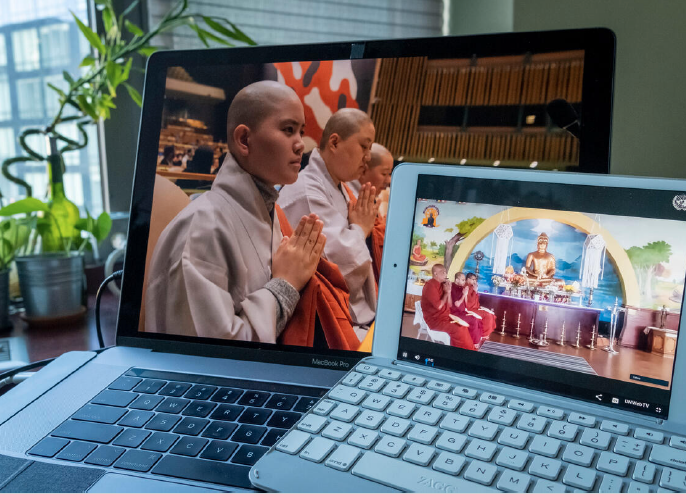
Credit: UN Photo/Loey Felipe
Minorities whose religious or belief practice is a prominent feature of their public life are more likely to direct aggression against their more powerful and advantaged counterparts in comparison to minority groups that take a private view on religious practice.31Steven L. Neuberg, Carolyn M. Warner, Stephen A. Mistler, Anna Berlin, Eric D. Hill, Jordan D. Johnson, Gabrielle Filip-Crawford, et al., “Religion and Intergroup Conflict: Findings from the Global Group Relations Project,” Psychological Science 25, no. 1 (January 2014): 198-206, https://doi.org/10.1177/0956797613504303.
In order to sustain conflict, actors may strategically exploit existing religious cleavages to justify violence, gain more allies, or harness the power and resources of religious infrastructure. In this way, religion can be used to mobilize religious supporters or to help secure control, resources, and perceived authority.
In light of these research findings, policymakers should avoid broad generalizations about the role of religion or belief in either driving or preventing conflict, nor should they assume a causal relationship between restrictions on religion or belief and violent conflict. Policymakers should, however, be concerned about the rising trends in violence based on religion or belief, specifically in relation to government force, mob violence, property damage, and the imposition of religious norms, and the ongoing impacts of religion-related armed conflicts and interreligious violence on civilians.
III. UN action to combat violence based on religion or belief
The Human Rights Council, the General Assembly, and the Security Council have all engaged recently on issues related to violence based on religion or belief, as summarized below.
Human Rights Council
With the landmark Resolution 16/18 (2011), the Human Rights Council set an ambitious agenda for “combating intolerance, negative stereotyping and stigmatisation of, and discrimination, incitement to violence, and violence against, persons based on religion or belief.” This resolution urged member states, among other things, to speak out against incitement to violence, and criminalize incitement to immediate violence based on religion or belief. The resolution recognized a link between restrictions on FoRB and violent conflict by noting that open, respectful fora for debate can prevent and counter religious tensions and violence.32UN Human Rights Council, Resolution 16/18, A/HRC/RES/16/18, March 24, 2011.
Importantly, the resolution called on member states to implement the 16/18 agenda domestically by countering religious profiling, preventing discrimination by civil servants, and appointing a section within their governments to monitor and address tensions between religious communities.33UN Human Rights Council, Resolution 16/18. In 2013, the Human Rights Council passed Resolution 22/31, which additionally required the High Commissioner for Human Rights to report on member states’ self-reported progress toward implementation of Resolution 16/18’s calls to action.34UN Human Rights Council, Resolution 22/31, A/HRC/RES/22/31, March 22, 2013. The Human Rights Council readopts the 16/18 action points and the request for reporting by the High Commissioner for Human Rights in an annual resolution.
General Assembly
In the 1981 UN Declaration, the General Assembly asserted that “the disregard and infringement of human rights and fundamental freedoms, in particular of the right to freedom of thought, conscience, religion or whatever belief, have brought, directly or indirectly, wars and great suffering to mankind.”35Declaration on the Elimination of All Forms of Intolerance and of Discrimination Based on Religion or Belief in UN General Assembly, Resolution 36/55, A/RES/36/55, November 25, 1981, para. 3. Such framing acknowledges the connection between restrictions on FoRB and armed conflict, making a compelling argument for continued action on this issue.
In the past decade, action by the General Assembly has largely focused on reinforcing Human Rights Council resolutions. In December 2011, the General Assembly re-affirmed the need for universal implementation of Human Rights Council Resolution 16/18 with the passage of Resolution 66/167, which also required the Secretary-General to report on member states’ implementation of the 16/18 action points.36UN General Assembly, Resolution 66/167, A/RES/66/167, December 19, 2011. The General Assembly continues to renew the calls to action and requests for reporting by the Secretary-General in an annual resolution.
In 2018, the General Assembly approved Resolution 73/176 (2018), which re-emphasized FoRB as a human right, alongside freedom of thought and conscience, and urged states to fully cooperate with the Special Rapporteur on FoRB in fulfillment of their mandate.37UN General Assembly, Resolution 73/176, A/RES/73/176, December 17, 2018. In 2019, the General Assembly adopted two additional resolutionson violence based on religion or belief. Resolution 73/285 condemned all acts of violence based on religion or belief,38UN General Assembly, Resolution 73/285, A/RES/73/285, April 2, 2019. and Resolution 73/296 created the International Day Commemorating the Victims of Acts of Violence Based on Religion or Belief to be recognized annually on August 22.39UN General Assembly, Resolution 73/296, A/RES/73/296, May 28, 2019.
Security Council
The Security Council has taken some actions recognizing religion as a factor in conflict. For example, thematic resolutions such as Resolution 2250 (2015) on youth, peace and security40UN Security Council, Resolution 2250 (2015), S/RES/2250 (2015), December 9, 2015, p. 2. and recent peacekeeping mandates for the UN peacekeeping mission in the Central African Republic41See, for example, UN Security Council, Resolution 2499 (2019), S/RES/2499 (2019), November 15, 2019. acknowledge that religious intolerance and violence can drive conflict. Similarly, resolutions on terrorism and violent extremism rightly assert that neither should be associated with any particular religion or nationality.
The Council has recently indicated that it may be willing to engage more actively with FoRB as a security matter. In August 2019, the Security Council hosted an Arria-formula meeting on “Advancing the safety and security of persons belonging to religious minorities in armed conflict,” in support of the International Day Commemorating the Victims of Acts of Violence Based on Religion or Belief. At this informal meeting, both China and Pakistan received strong censure from other member states about their egregious restrictions of religion or belief that severely undermine the lives and freedoms of religious minorities.42“China, Pakistan Targeted on Persecution of Religious Minorities at UNSC Meet,” Business Standard, August 23, 2019, https://www.business-standard.com/article/pti-stories/china-pakistan-targeted-on-persecution-of-religious-minorities-at-unsc-meet-119082300305_1.html.
These actions in the Human Rights Council, General Assembly, and Security Council have all contributed to reinforcing both FoRB generally and efforts against violence based on religion or belief specifically. In particular, the Human Rights Council forged an important path with Resolution 16/18, which helped build consensus on member state obligations and put a useful focus on the steps that member states should take domestically to promote FoRB. However, these efforts have also faced significant limitations. The Human Rights Council’s credibility as an institution has been undermined by the human rights records of some of its members and its inaction in the face of egregious human rights violations resulting from political interference by its members. These criticisms are poised to grow with new member states such as China, Nepal, Pakistan, Russia, and Uzbekistan,43UN General Assembly, “Elections of the Human Rights Council,” October 13, 2020, https://www.un.org/en/ga/75/meetings/elections/hrc.shtml. which are responsible for severe or high levels of violations of freedom of religion or belief,44Pew Research Center, In 2018, Government Restrictions on Religion Reach Highest Level Globally in More Than a Decade, p. 57. taking seats on the Human Rights Council in 2021.
The General Assembly’s effort to reinforce the 16/18 agenda by enshrining it in a General Assembly resolution lent added credibility to the agenda. However, General Assembly resolutions are, like Human Rights Council resolutions, non-binding, and implementation depends on the political will of member states. In practice, this means that this agenda suffers from under-implementation by member states. For example, in 2020 only 16 member states submitted contributions to inform the Secretary-General’s annual report, in response to a note verbale circulated by the Office of the High Commissioner for Human Rights.45UN Secretary-General, A/75/369 Report of the Secretary-General to the UN General Assembly, September 30, 2020, para. 2.
The Security Council has greater authority to compel action with its resolutions, but has only recently taken very modest steps to recognize the security dimensions of FoRB. As we discuss in the next section, there are several potential opportunities—as well as important risks—that could come if the Security Council engages with FoRB as a threat to international peace and security.
Overall, efforts by the Human Rights Council, General Assembly, and Security Council to prevent and combat violence based on religion or belief could benefit from greater member state attention and leadership. This could help create consistent pressure on all member states to meet their domestic requirements under Human Rights Council Resolution 16/18, to report on their progress to the Secretary-General and the High Commissioner for Human Rights, and to ensure that specific actions are taken to protect civilians from violence based on religion or belief.
IV. Risks and opportunities for strengthening UN action
Modern violence is increasingly targeted against individuals and communities based on their religion or belief. The previous section described recent actions by the UN to protect FoRB, but these actions have proven insufficient to address growing violence related to religion or belief. This section identifies risks and opportunities for UN member states to build on past UN action and strengthen efforts to protect FoRB at the Human Rights Council, the General Assembly, and the Security Council.
Compared to the Human Rights Council and the General Assembly, the Security Council has traditionally had little direct engagement with the FoRB agenda. Yet given the rising trends in violence based on religion or belief (including the spread of this type of violence to more countries and the increasingly severe impact on civilians of some forms of this violence), there are compelling reasons to consider more action by the Council going forward. More direct and sustained engagement by the Council could help prevent violence in a deteriorating situation, for example, and assist in providing support to stronger political strategies and longer-term accountability. Beyond specific country situations, the Council could consider looking at these violence trends to consider a more thematic, preventive approach overall for its agenda and to strengthen its own analysis. Furthermore, these trends overlap with the issue of violent extremism, and could better inform efforts of the sanctions committees and efforts to prevent financing and support to terrorist groups. Major arguments in favor of greater Security Council engagement on FoRB include:
- Enabling the Security Council to engage more preventively and effectively on situations that are already on the Council’s agenda. The Council has many conflict situations on its agenda where the Pew Research Center has assessed there to be high levels of violence based on religion or belief. These include the situations in Afghanistan, the Central African Republic, Iraq, Libya, Myanmar, Somalia, Syria, and Yemen. Yet the Council’s engagement on these situations is not consistently informed by a nuanced understanding of how religion or belief may play roles in triggering or sustaining conflict. The Council has responded to these conflicts without situating them within the broader trends in growing restrictions on FoRB and violence based on religion or belief. As a result, the Council may miss opportunities to better understand risk factors for violence, given the correlation between FoRB restrictions and violent conflict in some situations. It also means that the Council may miss opportunities with respect to identifying solutions. By drawing on the data on violence based on religion or belief, the Council could better identify tools that could be applied across different situations on its agenda for conflict prevention and resolution.
- Identifying early warning risks and taking action in country-specific conflict settings not currently on the Council’s agenda. The Council does not have on its agenda all conflict situations involving violence based on religion or belief. For example, Nigeria and the Philippines are identified by the Pew Research Center as having religion-related conflicts that resulted in hundreds of thousands and tens of thousands of civilians killed or displaced respectively, but they are not currently on the Council’s agenda. (While the Security Council has considered violence perpetrated by Boko Haram specifically as part of its discussion of the Lake Chad Basin area, violence based on religion or belief in Nigeria is broader than Boko Haram and is perpetrated by a range of state and non-state actors.) If the upward trends continue globally, this type of violence could become a greater threat to international peace and security, with increasing levels of violence and a wider geographic spread. Understanding these conflicts as manifestations of a broader trend of rising violence based on religion or belief could facilitate earlier, preventive, and more consistent engagement by the Security Council, including by giving the Council a stronger rationale for considering conflict situations not currently on its agenda.
- Paving the way for action in non-conflict settings where violence is high. Many egregious situations of violence based on religion or belief are taking place in contexts that are not currently recognized by the Security Council as threats to international peace and security. This includes, for example, mass atrocities in China and Nigeria (where, in addition to atrocities perpetrated by Boko Haram, some groups have identified atrocities perpetrated by Fulani militia).46All Parliamentary Group for International Freedom of Religion or Belief, Nigeria: Unfolding Genocide?, https://appgfreedomofreligionorbelief.org/media/200615-Nigeria-Unfolding-Genocide-Report-of-the-APPG-for-FoRB.pdf, p. 6. In some of these situations, the Council has been unable to take meaningful action because of political obstruction (particularly by China and Russia, which hold veto power). While there are no easy solutions to the problem of permanent members of the Council blocking action, building up both country-specific cases and thematic language would in the longer term support greater engagement by the Security Council on this agenda. Over time, this could help pave the way for more consistent action to combat violence based on religion or belief, including in situations that are not currently recognized by the Council as conflict situations. These actions would in turn help to reinforce the freedom of religion and belief as a universal norm and a human right, instead of attempting to uphold it only in specific, limited cases.
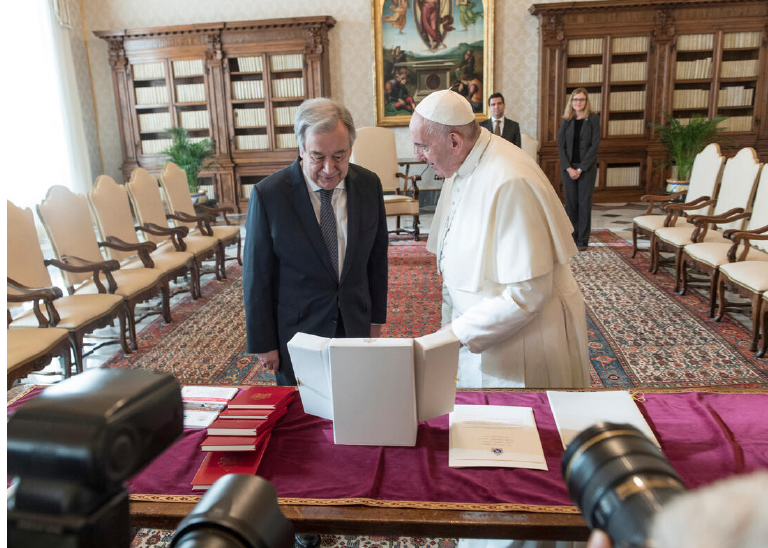
Credit: UN Photo/Rein Skullerud
Of course, some important challenges also come with Security Council engagement on FoRB. The governments of China and Russia have both imposed high levels of FoRB restrictions on their own populations, and both hold veto power on the Council. The Chinese government in particular is actively engaged in mass atrocities targeting predominantly Muslim Uyghurs and other Turkic Muslim communities. Any resolution or presidential statement would have to get past China’s and Russia’s objections—and in order to meet that bar, the text would likely be relatively toothless. It is even possible that no text could get past the veto while maintaining standards of international human rights law. Moreover, for the Council to engage with the issue, it must engage with it as a security challenge—that is, as a threat to international peace and security. Given the political obstacles, this would almost certainly require the Council to focus on the aspects of FoRB involving violence or with a strong link to violent conflict, rather than engaging with the broader FoRB agenda that includes both violent and non-violent forms of discrimination. Despite these drawbacks, we argue that greater action by the Council on this issue (complemented by stronger action at the Human Rights Council and the General Assembly on the full FoRB agenda) could help support the Security Council’s primary role in preventing and responding to conflict, as well as in supporting measures for accountability, human rights, and upholding the UN Charter.
Risks
There are important opportunities for UN member states to strengthen the FoRB agenda through the Security Council, the Human Rights Council, and the General Assembly. But UN action on this issue also comes with important risks that apply to all three bodies. FoRB experts consulted for this study identified two key risks as critical for UN member states to manage:
- Undermining other human rights, including rights related to gender and sexuality. Some member states have pitted FoRB against other human rights, dealing serious damage to both. In particular, FoRB has been misused to justify discrimination or violence against women, girls, and LGBTQ+ persons in the name of religious freedom. This history creates a serious risk that UN member states taking action on FoRB with the goal of preventing or countering violence based on religion or belief may instead facilitate further erosion of the rights of women, girls, and LGBTQ+ persons. Moreover, some experts caution that focusing action on one particular human right is inherently risky, since all human rights are interdependent and should be seen as mutually reinforcing. Singling out FoRB could make it harder to address it in a holistic way together with other human rights.
- Marginalizing non-Abrahamic religions and beliefs. There is a widespread perception, particularly within the Global South, that FoRB has been championed largely by Global North countries with a specific interest in protecting Christian minorities. This perceived bias creates understandable suspicion and sensitivities around actions that place special attention on FoRB compared to other human rights—particularly in the context of growing nationalist movements in Europe and North America linked to Christianity. Moreover, both scholarship and activism on FoRB have suffered from an over-emphasis on Abrahamic religions at the expense of other religions or beliefs, including Indigenous religions and beliefs, animist religions and beliefs (particularly those practiced on the African continent), and humanist, atheist, and secular beliefs. Any member state actions that reinforce these biases could have the effect of further marginalizing non-Abrahamic religions and beliefs.
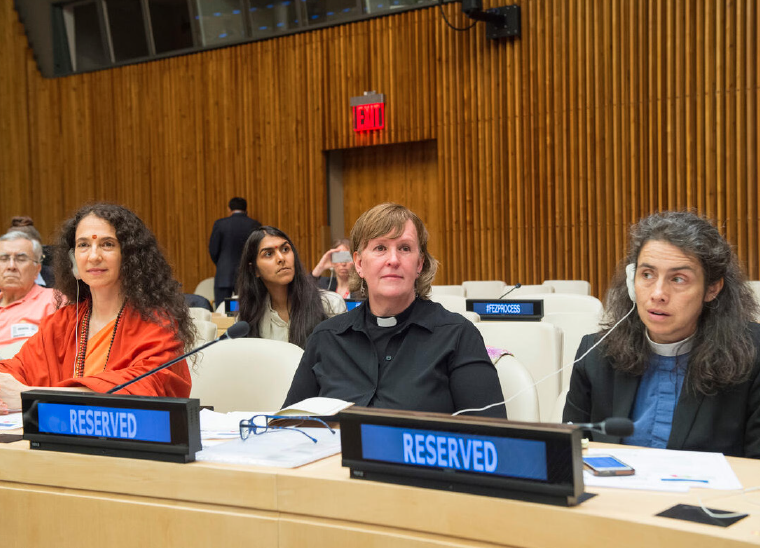
Credit: UN Photo/Eskinder Debebe
Opportunities
With careful attention to mitigate these risks, however, UN member states could take several actions to better prevent and respond effectively to rising levels of violence based on religion or belief worldwide. Member states could seize the following seven opportunities:
- Highlight the issue of violence based on religion or belief and call attention to upward trends. 2021 marks the 10th anniversary of Human Rights Council Resolution 16/18 (adopted in March 2011) and the 40th anniversary of the General Assembly Declaration on the Elimination of All Forms of Intolerance and of Discrimination Based on Religion or Belief (adopted in November 1981), and 2022 marks the 30th anniversary of the UN Declaration on the Rights of Persons Belonging to National or Ethnic, Religious and Linguistic Minorities (adopted in December 1992). These anniversaries offer an opportunity for member states to hold events, call attention to violence based on religion or belief, and advocate renewed action to advance the agenda. These activities could include requesting the Secretary-General to convene a High-Level Panel to perform a global study on how the UN can better protect FoRB. In addition, the Human Rights Council could hold a panel event to share lessons learned and outcomes from the Istanbul Process for Combating Intolerance, Discrimination, and Incitement to Hatred, and/or Violence on the Basis of Religion or Belief. This Istanbul Process follow-up meeting could be also turned into an annual informal event timed to coincide with the annual readoption of the 16/18 agenda in the Human Rights Council, as a way to generate more discussion between member states about progress made and to exchange ideas.
- Enhance FoRB capacities within the UN system. The Special Rapporteur on FoRB is mandated by the Human Rights Council to report objectively and systematically on violations of FoRB to the Human Rights Council and General Assembly, providing a critical resource in the context of heavy politicization of the FoRB agenda by member states. However, the Special Rapporteur position is unfunded and thus fulfilled on a voluntary and usually part-time basis. Member states could support converting the Special Rapporteur for FoRB into a salaried position, provide resources to enable more visits by the Special Rapporteur to member states, and provide additional staffing to the Special Rapporteur’s office to enable both additional thematic research and country-specific research and follow-up reporting after the Special Rapporteur’s country visits. In addition to reinforcing the capacity of the Special Rapporteur’s office, member states could consider requesting and funding FoRB focal points within the UNDP Crisis Response Unit, to reinforce links with broader UN priorities such as conflict prevention and the Sustainable Development Goals.
Member states should also support further research into the relationship between non-violent FoRB restrictions and armed conflict worldwide. Additional research could help policymakers understand whether and how such restrictions could be used as early warning indicators for conflict. This could offer important avenues to strengthen the Security Council’s engagement on FoRB as part of its broader conflict prevention strategy.
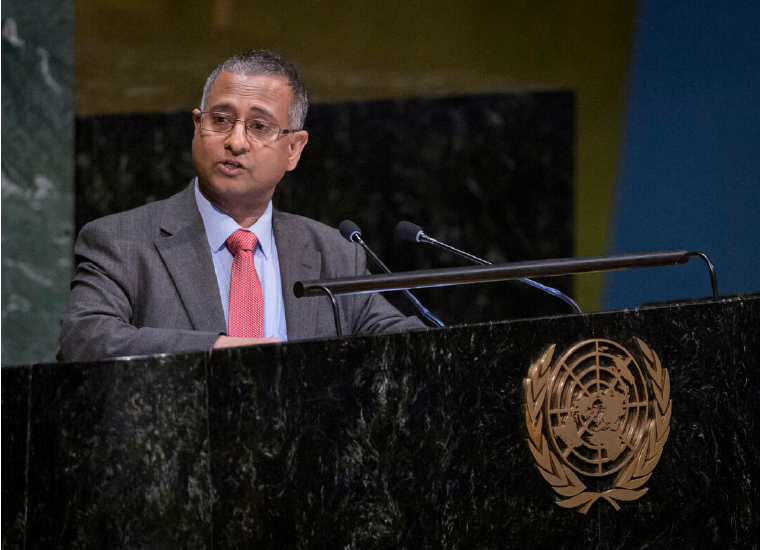
- Reinforce reporting on member states’ progress on domestic action. Member states could develop indicators for monitoring progress on the 16/18 calls to action and call on governments to generate national action plans for collecting data against those indicators. Current reporting efforts are undermined by low member state compliance and limited opportunities for civil society groups to share their perspectives with the UN. Member states could call for governments to establish confidential and accessible mechanisms for civil society to report on violations of FoRB, in partnership with the Special Rapporteur on FoRB. Greater attention placed on violence based on religion or belief at the UN, including at the Security Council, would create additional pressure for member states to fulfill existing reporting requests.
- Integrate language on preventing and combating violence based on religion or belief into related agendas. Combating violence based on religion or belief is part of the broader human rights agenda but also overlaps with many other agendas, including the protection of civilians; women, peace, and security; Indigenous rights; preventing mass atrocities and genocide; protection of cultural heritage; children and armed conflict; and preventing and countering violent extremism. Member states should consider integrating language on violence based on religion or belief and/or FoRB into resolutions on other relevant agendas. This language could also be tied to specific actions; for example, member states could request the Secretary-General to include a section on violence based on religion or belief in their annual report on the protection of civilians. Member states could also consider creating a target for FoRB within the Sustainable Development Goals through the General Assembly.
- Take country-specific actions to protect civilians in contexts with high levels of violence based on religion or belief. Human Rights Council members should, despite potential political opposition, attempt to establish Special Rapporteurs and/or fact-finding missions or other investigative mechanisms for mass atrocity crimes in contexts that have received too little attention at the UN, such as China’s targeting of predominantly Muslim Uyghurs and other religious minority groups. Should a member state not welcome such a mechanism within its borders, the investigative panel could gather evidence from afar, as in the case of the Democratic People’s Republic of Korea in 2013. Security Council members should consider passing a country-specific resolution on violence based on religion or belief in a conflict-affected context where there is sufficient member state agreement. This resolution could call attention to the roles that religion may play in perpetuating or resolving the conflict and draw special attention to atrocity crimes. A resolution could, for example, examine violence based on religion or belief perpetrated by all state and non-state actors in Nigeria. Alternatively, it could focus on violence perpetrated by a specific non-state actor such as Boko Haram or al-Shabaab. In addition, Council members could consider adding language on violence based on religion or belief into resolutions authorizing peace operations in areas with high levels of violence based on religion or belief. This language could, for example, remind all parties to the peace of FoRB rights (and the need for inclusive peace agreements), express concern over violence based on religion or belief taking place in the peace operation’s area of deployment, or request the peace operation to consider violence based on religion or belief as part of its analysis and activities related to the protection of civilians.
- Introduce a thematic resolution at the Security Council. Given rising trends in violence based on religion or belief, and the links between FoRB restrictions and violent conflict, there is a compelling reason for the Security Council to engage with this agenda as a security issue. Security Council members should consider introducing a thematic resolution on violence based on religion or belief generally, or on the protection of religious minorities in conflict settings more narrowly. The aim of this resolution would be to define the agenda in a broad and inclusive way, acknowledge the connections between FoRB and other human rights, and sensitize the Council to this issue so that it can engage with it more actively over time. In applying this recommendation, member states must ensure that the resolution does not inadvertently perpetuate misconceptions about religion and conflict, undermine other human rights, or marginalize non-Abrahamic religions or beliefs.
- Encourage the Security Council to stay engaged on these issues. Security Council members should also consider holding additional Arria-formula meetings on violence based on religion or belief and could also request informal briefings by the Special Rapporteur on FoRB or from country-specific Special Rapporteurs, Independent Experts, or Groups of Experts. (Currently, there are Special Rapporteurs on Eritrea, Iran, Myanmar, and North Korea, Independent Experts on the Central African Republic and Sudan, 47U.S. Commission on International Religious Freedom, https://www.uscirf.gov/sites/default/files/2020%20Factsheet%20-%20UN%20HR%20Mechanisms.pdf“Factsheet: UN Human Rights System,” October 2020, https://www.uscirf.gov/sites/default/files/2020%20Factsheet%20-%20UN%20HR%20Mechanisms.pdf, p. 3.a Group of Eminent Experts on Yemen, and a Team of Experts on the Kasaï region.)48United Nations Human Rights Council, “List of HRC-Mandated Commissions of Inquiries / Fact-Finding Missions & Other Bodies,” October 2019, https://www.ohchr.org/EN/HRBodies/HRC/Pages/ListHRCMandat.aspx. Security Council members could further ask for a briefing by the UN Office on Genocide Prevention and the Responsibility to Protect on the main risk indicators related to religion or belief in the Framework of Analysis for Atrocity Crimes. Council members could also request that the UN Secretary-General and/or the Office of the High Commissioner for Human Rights routinely share relevant findings from Commissions of Inquiry, Fact-Finding Missions, or other independent investigative mechanisms. Recent trends in increased violence based on religion or belief are deeply concerning. The international community, including the UN, should understand the immense harm this type of violence can create—as an erosion of human rights, as a feature of mass atrocities, as a threat to governance, sovereignty, and the rule of law, and as a risk factor in violent conflict. UN bodies including the Human Rights Council, the General Assembly, and the Security Council have taken important steps to combat this type of violence, but UN member states should strengthen and build on those activities in order to reverse rising trends and protect civilians from violence based on religion or belief.
——
Acknowledgements
The authors offer thanks to the many experts who shared insights that informed this analysis, particularly to Victoria K. Holt, Paul Romita, Ahmed Shaheed, Knox Thames, and Madeline Vellturo for reviewing drafts of this issue brief and speaking with the authors one-on-one. Others interviewed for this initiative include Elisabet le Roux, Ani Sarkissian, Lisa Sharland, Mine Yildirim, and Kelsey Zorzi. Further thanks go to the participants of the closed-door expert workshop “Violence Based on Religion or Belief: Opportunities for UN Action,” held on November 20, 2020 by the Stimson Center. Workshop participants include Matthias Basedau, Elizabeth Cassidy, Roger Finke, Palwasha L. Kakar, Jason Klocek, Elisabet le Roux, Melissa Nozell, Fabio Petito, and Kate E. Temoney. Any remaining errors are the responsibility of the authors.
Notes
- 1Appendices D and F in Samirah Majumdar and Virginia Villa, In 2018, Government Restrictions on Religion Reach Highest Level Globally in More Than a Decade, Pew Research Center, November 10, 2020, https://www.pewforum.org/2020/11/10/in-2018-government-restrictions-on-religion-reach-highest-level-globally-in-more-than-a-decade/.
- 2The Pew Research Center categorizes state activities under government force when they “resulted in individuals being killed, physically abused, imprisoned, detained or displaced from their homes, or having their personal or religious properties damaged or destroyed.” Pew Research Center, Appendix D, p. 79.
- 3Pew Research Center, In 2018, Government Restrictions on Religion Reach Highest Level Globally in More Than a Decade, p. 28.
- 4Special Rapporteur on Freedom of Religion or Belief, A/HRC/37/49: Report on State-Religion Relationships and Their Impact on Freedom of Religion or Belief, March 2018, UN Office of the High Commissioner for Human Rights, https://www.ohchr.org/EN/Issues/FreedomReligion/Pages/ReportStateReligionRelationships.aspx, para. 41.
- 5“Sri Lanka” in 2019 Report on International Religious Freedom, U.S. Department of State, June 10, 2020, https://www.state.gov/reports/2019-report-on-international-religious-freedom/sri-lanka/.
- 6The Pew Research Center defines social hostilities involving religion as “acts of religion-related hostility by private individuals, organizations or groups in society.” Pew Research Center, In 2018, Government Restrictions on Religion Reach Highest Level Globally in More Than a Decade, p. 12.
- 7Pew Research Center, In 2018, Government Restrictions on Religion Reach Highest Level Globally in More Than a Decade, p. 12.
- 8U.S. Commission on International Religious Freedom, Annual Report 2020, April 2020, https://www.uscirf.gov/sites/default/files/USCIRF%202020%20Annual%20Report_Final_42920.pdf, p. 20.
- 9U.S. Commission on International Religious Freedom, Annual Report 2020.
- 10The Pew Research Center defines religion-related terrorism as “politically motivated violence against noncombatants by subnational groups or clandestine agents with a religious justification or intent.” Pew Research Center, Appendix D, p. 87.
- 11The Pew Research Center defines religion-related armed conflict as when in armed conflict “religious rhetoric is commonly employed to justify the use of force, or in which one or more of the combatants primarily identifies itself or the opposing side by religion.” Pew Research Center, Appendix D, p. 88.
- 12The Pew Research Center defines interreligious violence as “acts of sectarian or communal violence between religious groups.” Pew Research Center, A Closer Look at How Religious Restrictions Have Risen Around the World, July 15, 2019, p. 32.
- 13Pew Research Center, A Closer Look at How Religious Restrictions Have Risen Around the World, p. 32.
- 14Minority Rights Group International, Peoples under Threat 2018, https://minorityrights.org/wp-content/uploads/2018/06/Peoples-under-Threat-briefing-2018.pdf, p. 9.
- 15Special Rapporteur on Freedom of Religion or Belief, A/75/385: Report on Safeguarding Freedom of Religion or Belief for the Successful Implementation of the 2030 Agenda for Sustainable Development, United Nations Office of the High Commissioner for Human Rights, 16 October 2020, https://www.ohchr.org/EN/Issues/FreedomReligion/Pages/ReportFoRBandSDGs.aspx, para. 37 and 38
- 16Lauren Baillie and Rachel Vandenbrink, “China: The International Community Is Failing Xinjiang’s Uyghurs,” United States Institute of Peace, December 30, 2020, https://www.usip.org/publications/2020/12/china-international-community-failing-xinjiangs-uyghurs.
- 17Ewelina U. Ochab, “After Years of Impunity for Mass Atrocities, Nigeria Faces a New Wave of Violence by a Daesh Affiliated Group,” Forbes, February 20, 2020, https://www.forbes.com/sites/ewelinaochab/2020/02/20/after-years-of-impunity-for-mass-atrocities-nigeria-faces-a-new-wave-of-violence-by-a-daesh-affiliated-group/?sh=565e367b77c7.
- 18See Matthias Basedau and Johanna Schaefer-Kehnert, “Religious Discrimination and Religious Armed Conflict in Sub-Saharan Africa: An Obvious Relationship?,” Religion, State & Society 47, no. 1 (2019): 30-47, https://doi.org/10.1080/09637494.2018.1531617; David Muchilinski, “The Politics and Effects of Religious Grievance,” Oxford Research Encyclopedia of Politics, September 30, 2019, https://doi.org/10.1093/acrefore/9780190228637.013.783.
- 19Basedau and Schaefer-Kehnert.
- 20U.S. Commission on International Religious Freedom, “Did You Know. . . Non-State Actors,” accessed January 12, 2020, https://www.uscirf.gov/publications/did-you-knownon-state-actors.
- 21Pew Research Center, In 2018, Government Restrictions on Religion Reach Highest Level Globally in More Than a Decade, p. 14.
- 22Pew Research Center, In 2018, Government Restrictions on Religion Reach Highest Level Globally in More Than a Decade, p. 17.
- 23Renate Ysseldyk, Kimberly Matheson, and Hymie Anisman, “Religiosity as Identity: Toward an Understanding of Religion from a Social Identity Perspective,” Personality and Social Psychology Review 14, no. 1 (February 2010): 60-71, https://doi.org/10.1177/1088868309349693.
- 24Matthias Basedau, Birte Pfeiffer, and Johannes Vüllers, “Bad Religion? Religion, Collective Action, and the Onset of Armed Conflict in Developing Countries,” Journal of Conflict Resolution 60, no. 2 (March 2016): 226-255, https://doi.org/10.1177/0022002714541853.
- 25Jonathan Fox, “Clash of Civilizations or Clash of Religions: Which Is a More Important Determinant of Ethnic Conflict?” Ethnicities 1, no. 3 (September 2001): 295-320, https://doi.org/10.1177/146879680100100302.
- 26Henk-Jan Brinkman, Larry Attree, and Saša Hezir, “Addressing Horizontal Inequalities as Drivers of Conflict in the Post-2015 Development Agenda,” Saferworld, 2013, https://gsdrc.org/document-library/addressing-horizontal-inequalities-as-drivers-of-conflict-in-the-post-2015-development-agenda/.
- 27Special Rapporteur on Freedom of Religion or Belief, A/75/385, para. 31.
- 28Basedau, Pfeiffer, and Vüllers.
- 29Matthias Basedau, Johannes Vüllers, and Peter Körner, “What Drives Inter-Religious Violence? Lessons from Nigeria, Côte d’Ivoire, and Tanzania,” Studies in Conflict & Terrorism 36, no. 10 (2013): 857-879, https://doi-org. 10.1080/1057610X.2013.823761.
- 30Basedau, Pfeiffer, and Vüllers.
- 31Steven L. Neuberg, Carolyn M. Warner, Stephen A. Mistler, Anna Berlin, Eric D. Hill, Jordan D. Johnson, Gabrielle Filip-Crawford, et al., “Religion and Intergroup Conflict: Findings from the Global Group Relations Project,” Psychological Science 25, no. 1 (January 2014): 198-206, https://doi.org/10.1177/0956797613504303.
- 32UN Human Rights Council, Resolution 16/18, A/HRC/RES/16/18, March 24, 2011.
- 33UN Human Rights Council, Resolution 16/18.
- 34UN Human Rights Council, Resolution 22/31, A/HRC/RES/22/31, March 22, 2013.
- 35Declaration on the Elimination of All Forms of Intolerance and of Discrimination Based on Religion or Belief in UN General Assembly, Resolution 36/55, A/RES/36/55, November 25, 1981, para. 3.
- 36UN General Assembly, Resolution 66/167, A/RES/66/167, December 19, 2011.
- 37UN General Assembly, Resolution 73/176, A/RES/73/176, December 17, 2018.
- 38UN General Assembly, Resolution 73/285, A/RES/73/285, April 2, 2019.
- 39UN General Assembly, Resolution 73/296, A/RES/73/296, May 28, 2019.
- 40UN Security Council, Resolution 2250 (2015), S/RES/2250 (2015), December 9, 2015, p. 2.
- 41See, for example, UN Security Council, Resolution 2499 (2019), S/RES/2499 (2019), November 15, 2019.
- 42“China, Pakistan Targeted on Persecution of Religious Minorities at UNSC Meet,” Business Standard, August 23, 2019, https://www.business-standard.com/article/pti-stories/china-pakistan-targeted-on-persecution-of-religious-minorities-at-unsc-meet-119082300305_1.html.
- 43UN General Assembly, “Elections of the Human Rights Council,” October 13, 2020, https://www.un.org/en/ga/75/meetings/elections/hrc.shtml.
- 44Pew Research Center, In 2018, Government Restrictions on Religion Reach Highest Level Globally in More Than a Decade, p. 57.
- 45UN Secretary-General, A/75/369 Report of the Secretary-General to the UN General Assembly, September 30, 2020, para. 2.
- 46All Parliamentary Group for International Freedom of Religion or Belief, Nigeria: Unfolding Genocide?, https://appgfreedomofreligionorbelief.org/media/200615-Nigeria-Unfolding-Genocide-Report-of-the-APPG-for-FoRB.pdf, p. 6.
- 47U.S. Commission on International Religious Freedom, https://www.uscirf.gov/sites/default/files/2020%20Factsheet%20-%20UN%20HR%20Mechanisms.pdf“Factsheet: UN Human Rights System,” October 2020, https://www.uscirf.gov/sites/default/files/2020%20Factsheet%20-%20UN%20HR%20Mechanisms.pdf, p. 3.
- 48United Nations Human Rights Council, “List of HRC-Mandated Commissions of Inquiries / Fact-Finding Missions & Other Bodies,” October 2019, https://www.ohchr.org/EN/HRBodies/HRC/Pages/ListHRCMandat.aspx.

